The Ability of Selected European Countries to Face the Impending Economic Crisis Caused by COVID-19 in the Context of the Global Economic Crisis of 2008
Abstract
1. Introduction
2. Materials and Methods
3. Results
3.1. Economic Indicators Development
3.2. The Impact of Tax Revenues on the GDP
3.2.1. Group 1
3.2.2. Group 2
3.2.3. Group 3
3.2.4. Group 4
4. Discussion
5. Conclusions
Supplementary Materials
Author Contributions
Funding
Conflicts of Interest
References
- Ağca, Şenay, and Deniz Igan. 2019. Fiscal consolidations and the cost of credit. Journal of International Economics 120: 84–108. [Google Scholar] [CrossRef]
- Alesina, Alberto, Carlo Favero, and Francesco Giavazzi. 2015. The output effect of fiscal consolidation plans. Journal of International Economics 96: S19–S42. [Google Scholar] [CrossRef]
- Alesina, Alberto, Omar Barbiero, Carlo Favero, Francesco Giavazzi, and Matteo Paradisi. 2017. The Effects of Fiscal Consolidations: Theory and Evidence (No. w23385). Cambridge: National Bureau of Economic Research. Available online: https://www.nber.org/papers/w23385.pdf (accessed on 22 July 2020).
- Anderson, Derek, Benjamin Hunt, and Stephen Snudden. 2014. Fiscal consolidation in the euro area: How much pain can structural reforms ease? Journal of Policy Modeling 36: 785–99. [Google Scholar] [CrossRef]
- Antelo, Manel, and David Peón. 2014. Fiscal consolidation and the sustainability of public debt in the GIPSI countries. Cuadernos de Economía 37: 52–71. [Google Scholar] [CrossRef]
- Attinasi, Maria Grazia, and Luca Metelli. 2017. Is fiscal consolidation self-defeating? A panel-VAR analysis for the Euro area countries. Journal of International Money and Finance 74: 147–64. [Google Scholar] [CrossRef]
- Banerjee, Ryan, and Fabrizio Zampolli. 2019. What drives the short-run costs of fiscal consolidation? Evidence from OECD countries. Economic Modelling 82: 420–36. [Google Scholar] [CrossRef]
- Caselli, Paola. 2001. Fiscal consolidation under fixed exchange rates. European Economic Review 45: 425–50. [Google Scholar] [CrossRef]
- Castro, Vítor. 2017. The impact of fiscal consolidations on the functional components of government expenditures. Economic Modelling 60: 138–50. [Google Scholar] [CrossRef]
- Cimadomo, Jacopo, Sebastian Hauptmeier, and Tom Zimmermann. 2014. Fiscal consolidations and bank balance sheets. Journal of International Money and Finance 45: 74–90. [Google Scholar] [CrossRef][Green Version]
- Comisión Europea. 2020a. European Economic Forescast Spring 2020. Available online: https://ec.europa.eu/info/sites/info/files/economy-finance/ip125_en.pdf (accessed on 22 July 2020).
- Comisión Europea. 2020b. European Economic Forescast Summer 2020. Available online: https://ec.europa.eu/info/sites/info/files/economy-finance/ip132_en.pdf (accessed on 22 July 2020).
- Comisión Europea. 2020c. Recovery Plan for Europe. Available online: https://ec.europa.eu/info/live-work-travel-eu/health/coronavirus-response/recovery-plan-europe_en#documents (accessed on 22 July 2020).
- Comisión Europea. 2020d. Recovery of Euro Area and EU Economic Sentiment Intensifies—Employment Expectations again Up. Available online: https://ec.europa.eu/info/sites/info/files/full_bcs_2020_06_en.pdf (accessed on 22 July 2020).
- Croissant, Yves, and Giovanni Millo. 2008. Panel Data Econometrics in R: The Plm Package. Journal of Statistical Software 27: 1–43. [Google Scholar] [CrossRef]
- De Vito, Antonio, and Juan-Pedro Gomez. 2020. Estimating the COVID-19 cash crunch: Global evidence and policy. Journal of Accounting and Public Policy 39: 106741. [Google Scholar] [CrossRef]
- Dimitras, Augustinos I., Maria I. Kyriakou, and George Iatridis. 2015. Financial crisis, GDP variation and earnings management in Europe. Research in International Business and Finance 34: 338–54. [Google Scholar] [CrossRef]
- Erceg, Christopher J., and Jesper Lindé. 2013. Fiscal consolidation in a currency union: Spending cuts vs. tax hikes. Journal of Economic Dynamics and Control 37: 422–45. [Google Scholar] [CrossRef]
- Fatás, Antonio, and Lawrence H. Summers. 2018. The permanent effects of fiscal consolidations. Journal of International Economics 112: 238–50. [Google Scholar] [CrossRef]
- Feld, Lars P., and Gebhard Kirchgässner. 2003. The impact of corporate and personal income taxes on the location of firms and on employment: Some panel evidence for the Swiss cantons. Journal of Public Economics 87: 129–55. [Google Scholar] [CrossRef]
- Fernandes, Nuno. 2020. Economic Effects of Coronavirus Outbreak (COVID-19) on the World Economy. Available online: http://www.agoraceg.org/system/files/iese_impact_covid19.pdf (accessed on 22 July 2020).
- Garrett, Thomas A. 2007. Economic Effects of the 1918 Influenza Pandemic. Available online: http://www.indexinvestor.com/resources/Research-Materials/Disease/Economic_Impact_of_1918_Influenza.pdf (accessed on 22 July 2020).
- Goldman Sachs. 2020. Reopening the Economy. April 28. Available online: https://www.goldmansachs.com/insights/talks-at-gs/04-30-2020-phasing-in-the-reopening-of-the-economy-f/presentation.pdf (accessed on 22 July 2020).
- Heylen, Freddy, and Gerdie Everaert. 2000. Success and failure of fiscal consolidation in the OECD: A multivariate analysis. Public Choice 105: 103–24. [Google Scholar] [CrossRef]
- Honda, Yuzo. 1985. Testing the Error Components Model with Non-Normal Disturbances. The Review of Economic Studies 52: 681–90. [Google Scholar] [CrossRef]
- Jones, Erik. 2016. Competitiveness and the European financial crisis. In The Political and Economic Dynamics of the Eurozone Crisis. Oxford: Oxford University Press, pp. 79–99. [Google Scholar]
- Lee, Young, and Roger H. Gordon. 2005. Tax structure and economic growth. Journal of Public Economics 89: 1027–43. [Google Scholar] [CrossRef]
- Lee, Jong-Wha, and Warwick J. McKibbin. 2004. Estimating the global economic costs of SARS. In Learning from SARS: Preparing for the Next Disease Outbreak: Workshop Summary; Washington, DC: National Academies Press, April, p. 92. Available online: https://www.ncbi.nlm.nih.gov/books/NBK92473/ (accessed on 22 July 2020).
- Lemoine, Matthieu, and Jesper Lindé. 2016. Fiscal consolidation under imperfect credibility. European Economic Review 88: 108–41. [Google Scholar] [CrossRef]
- Leung, Kathy, Joseph T. Wu, Di Liu, and Gabriel M. Leung. 2020. First-wave COVID-19 transmissibility and severity in China outside Hubei after control measures, and second-wave scenario planning: A modelling impact assessment. The Lancet 395: 1382–93. [Google Scholar] [CrossRef]
- Manganelli, Benedetto, Pierluigi Morano, Paolo Rosato, and Pierfrancesco De Paola. 2020. The Effect of Taxation on Investment Demand in the Real Estate Market: The Italian Experience. Buildings 10: 115. [Google Scholar] [CrossRef]
- Moody’s Analytics. 2020. Europe Economic Outlook: Global Recession. April. Available online: https://www.moodysanalytics.com/-/media/presentation/2020/europe-economic-outlook.pdf (accessed on 22 July 2020).
- O’Connor, Casey M., Afshin A. Anoushiravani, Matthew R. DiCaprio, William L. Healy, and Richard Iorio. 2020. Economic recovery after the COVID-19 pandemic: Resuming elective orthopedic surgery and total joint arthroplasty. The Journal of Arthroplasty 35: 32–36. [Google Scholar] [CrossRef]
- OECD. 2011. Fiscal consolidation: Targets, plans and measures. OECD Journal on Budgeting 11: 2. [Google Scholar] [CrossRef]
- OECD. 2013. Government at a Glance 2013. Paris: OECD Publishing. [Google Scholar] [CrossRef]
- Plackett, Robin L. 1983. Karl Pearson and the Chi-Squared Test. International Statistical Review/Revue Internationale de Statistique 51: 59–72. [Google Scholar] [CrossRef]
- Qiu, Wuqi, Cordia Chu, Ayan Mao, and Jing Wu. 2018. The Impacts on Health, Society, and Economy of SARS and H7N9 Outbreaks in China: A Case Comparison Study. Journal of Environmental and Public Health 2018: 1–7. [Google Scholar] [CrossRef] [PubMed]
- Reicher, Claire. 2014. A set of estimated fiscal rules for a cross-section of countries: Stabilization and consolidation through which instruments? Journal of Macroeconomics 42: 184–98. [Google Scholar] [CrossRef]
- Standard & Poor’s. 2020. Large Risks to Growth Ahead_European Economic Snapshots, 4th May. Available online: https://www.standardandpoors.com/pt_LA/delegate/getPDF?articleId=2424390&type=COMMENTS&subType (accessed on 22 July 2020).
- Villar Rubio, Elena, Quesada Rubio, José Manuel, and Valentín Molina Moreno. 2015. Convergence analysis of environmental fiscal pressure across EU-15 countries. Energy & Environment 26: 789–802. [Google Scholar] [CrossRef]
- Von Hagen, Jürgen, and Rolf R. Strauch. 2001. Fiscal consolidations: Quality, conomic conditions, and success. Public Choice 109: 327–46. [Google Scholar] [CrossRef]
- White, Halbert. 1980. A Heteroskedasticity-Consistent Covariance Matrix Estimator and a Direct Test for Heteroskedasticity. Econometrica: Journal of the Econometric Society 48: 817–38. Available online: https://econpapers.repec.org/RePEc:ecm:emetrp:v:48:y:1980:i:4:p:817-38 (accessed on 22 July 2020). [CrossRef]
- Williams, Richard. 2015. Panel Data 4: Fixed Effects vs. Random Effects Models. University of Notre Dame. Available online: https://www3.nd.edu/~rwilliam/stats3/panel04-fixedvsrandom.pdf (accessed on 22 July 2020).
- Wooldridge, Jeffrey M. 2002. Econometric Analysis of Cross Section and Panel Data. Cambridge: MIT Press, pp. 1–735. Available online: https://jrvargas.files.wordpress.com/2011/01/wooldridge_j-_2002_econometric_analysis_of_cross_section_and_panel_data.pdf (accessed on 22 July 2020).
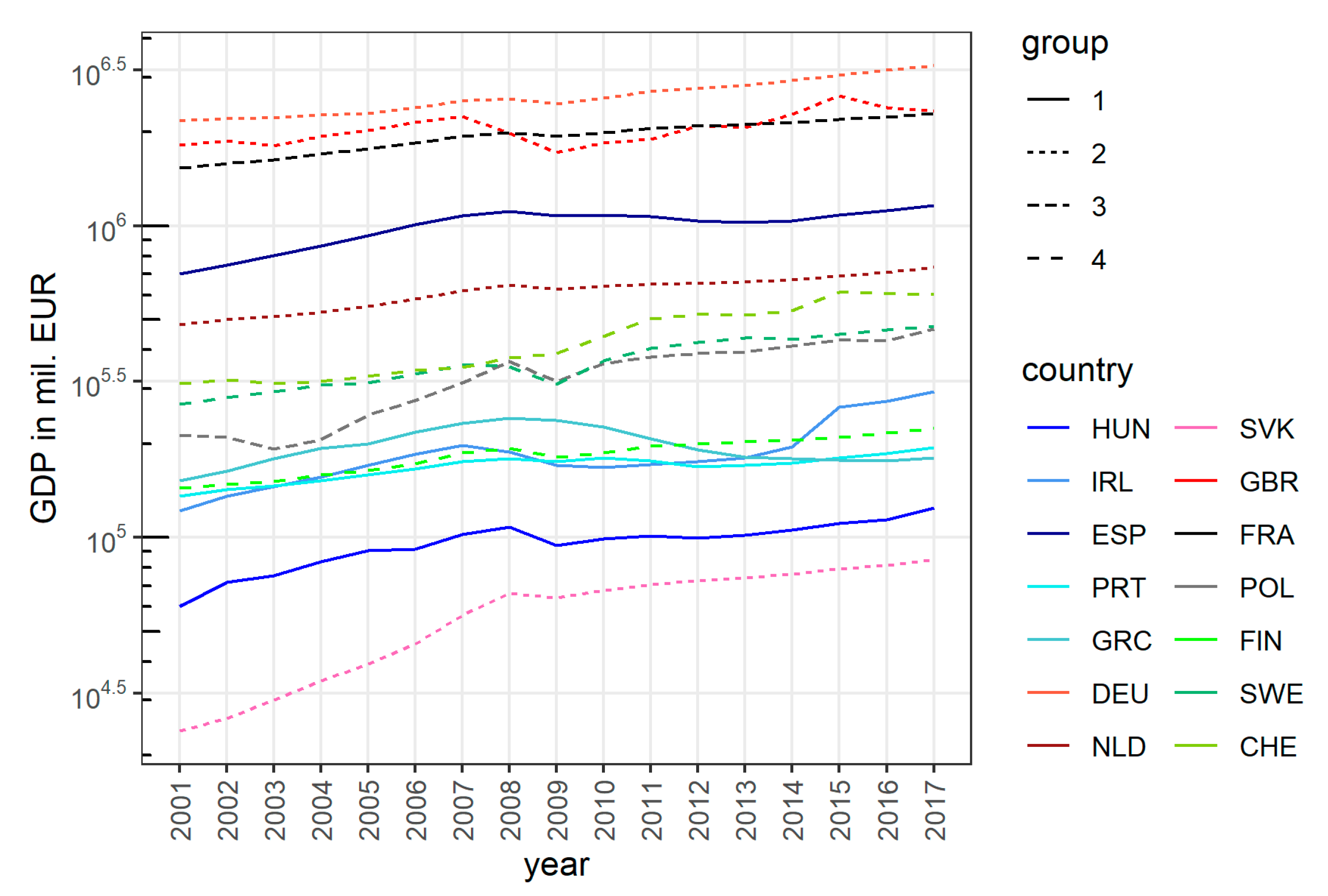
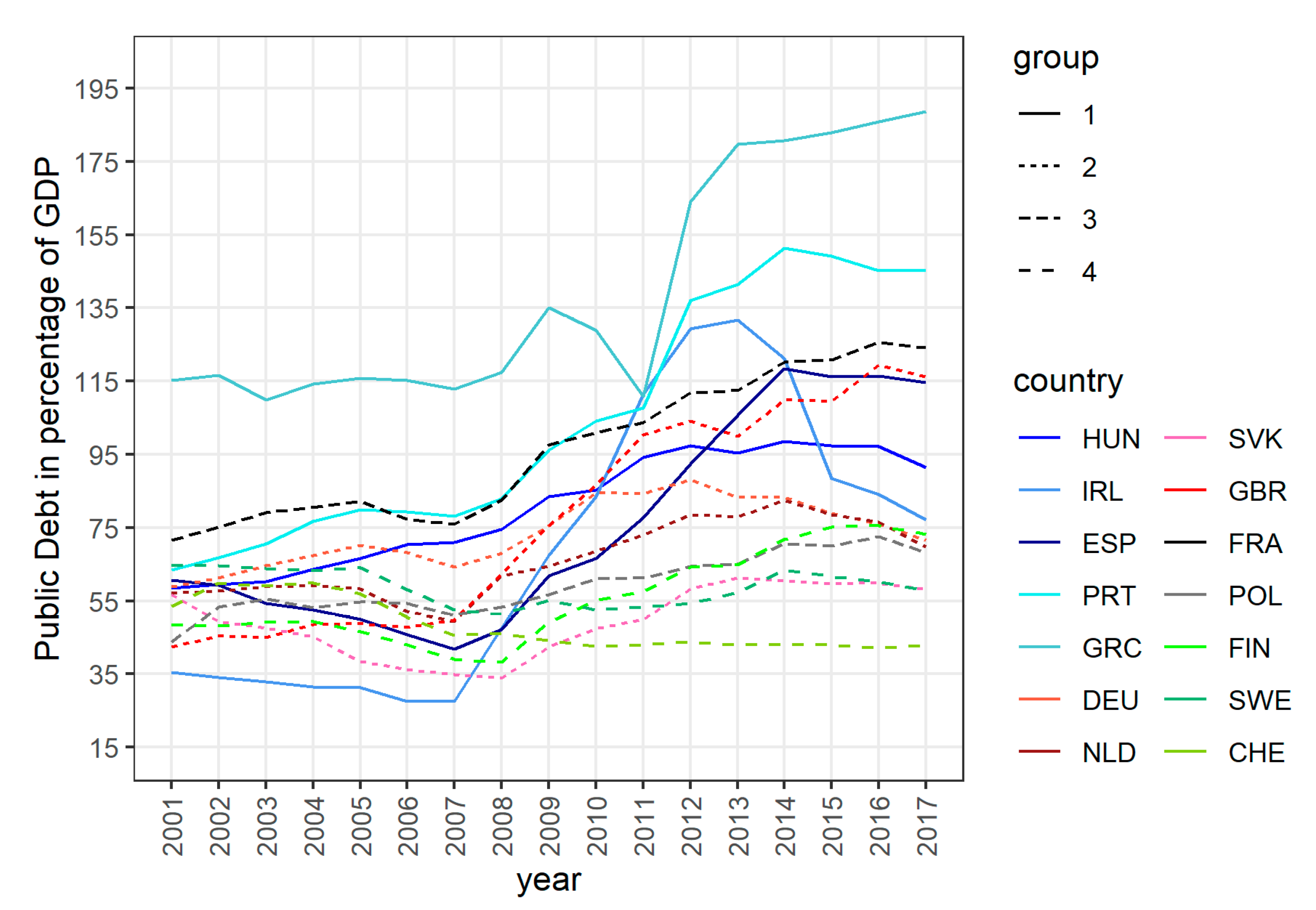
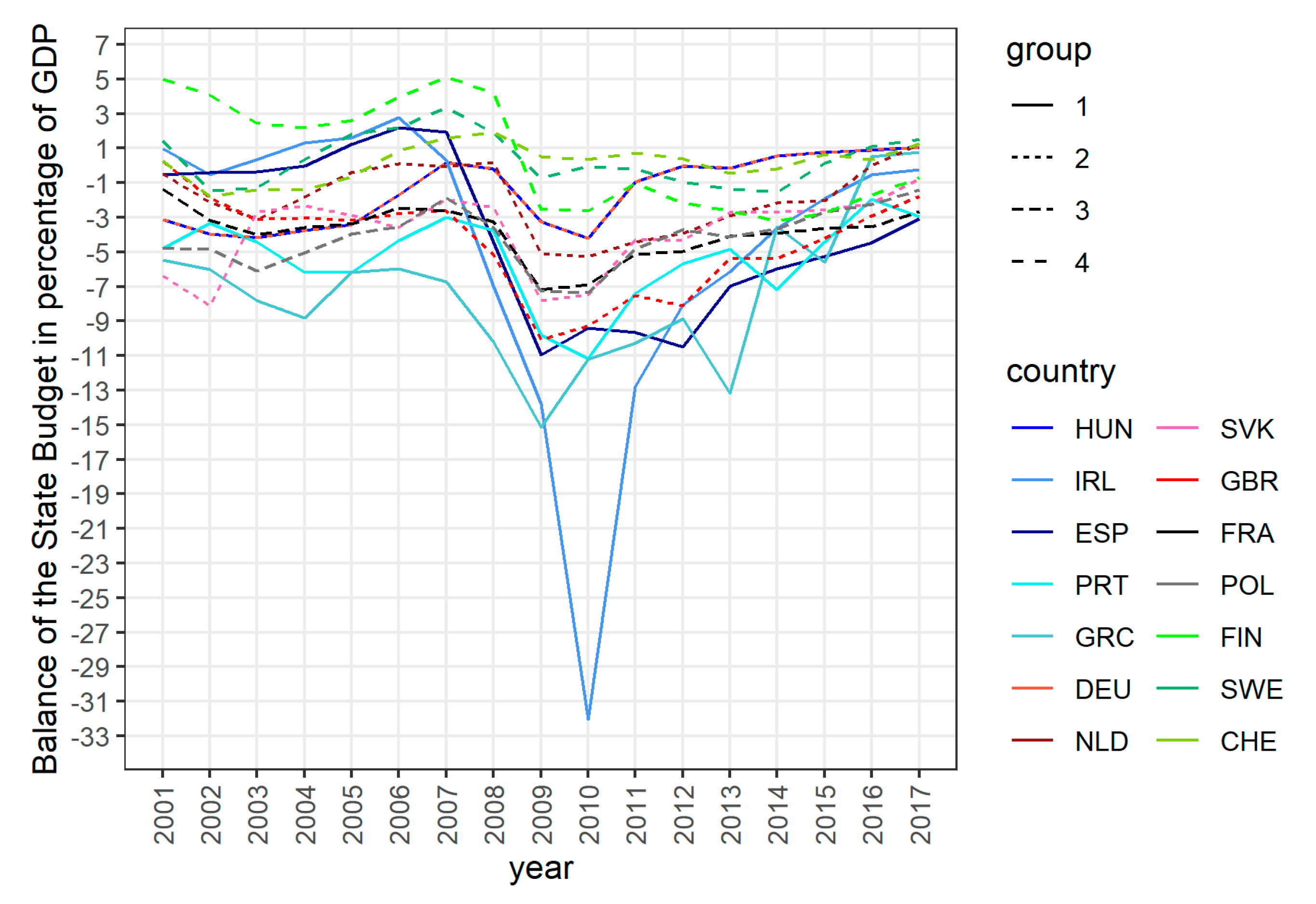
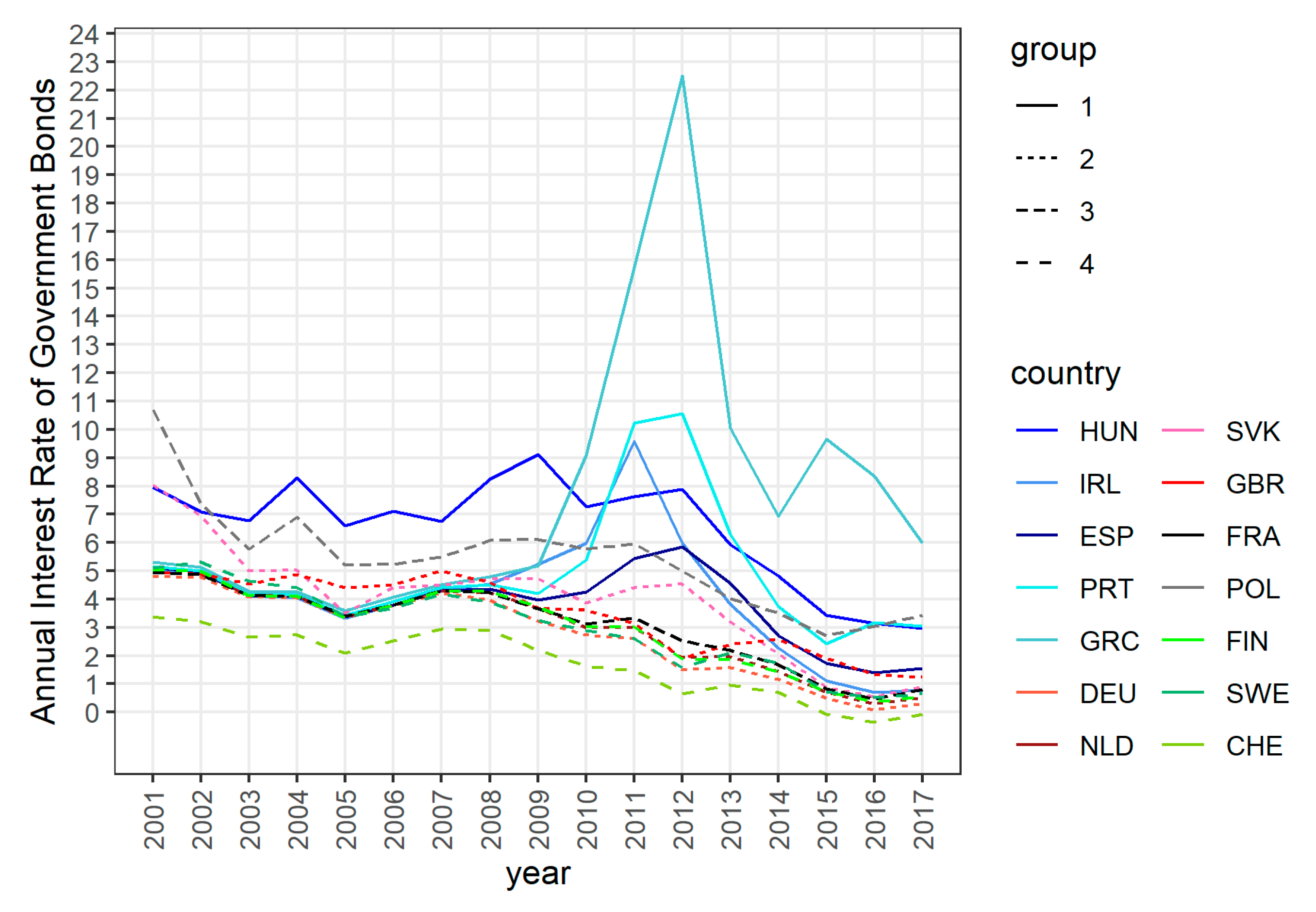
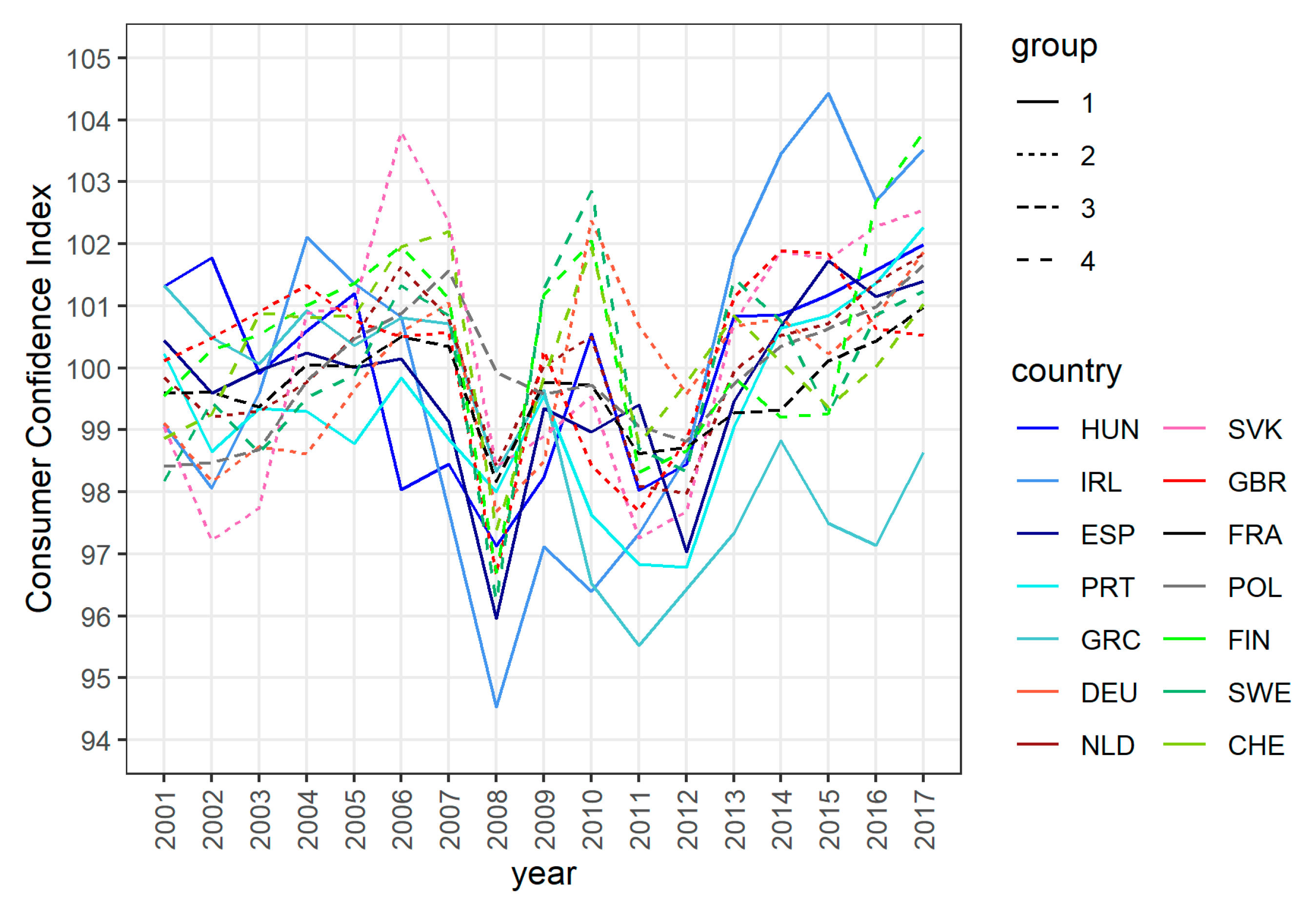
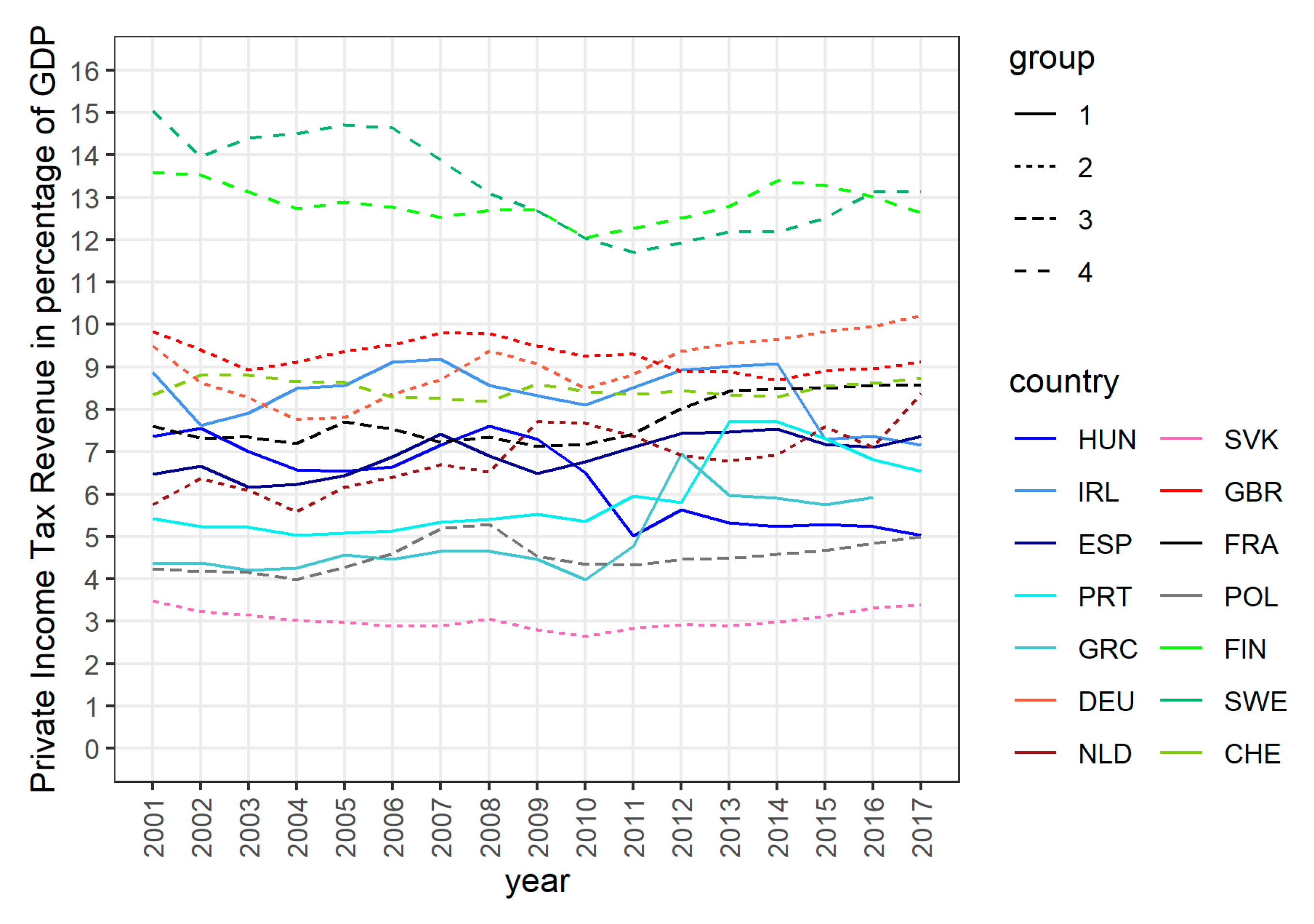
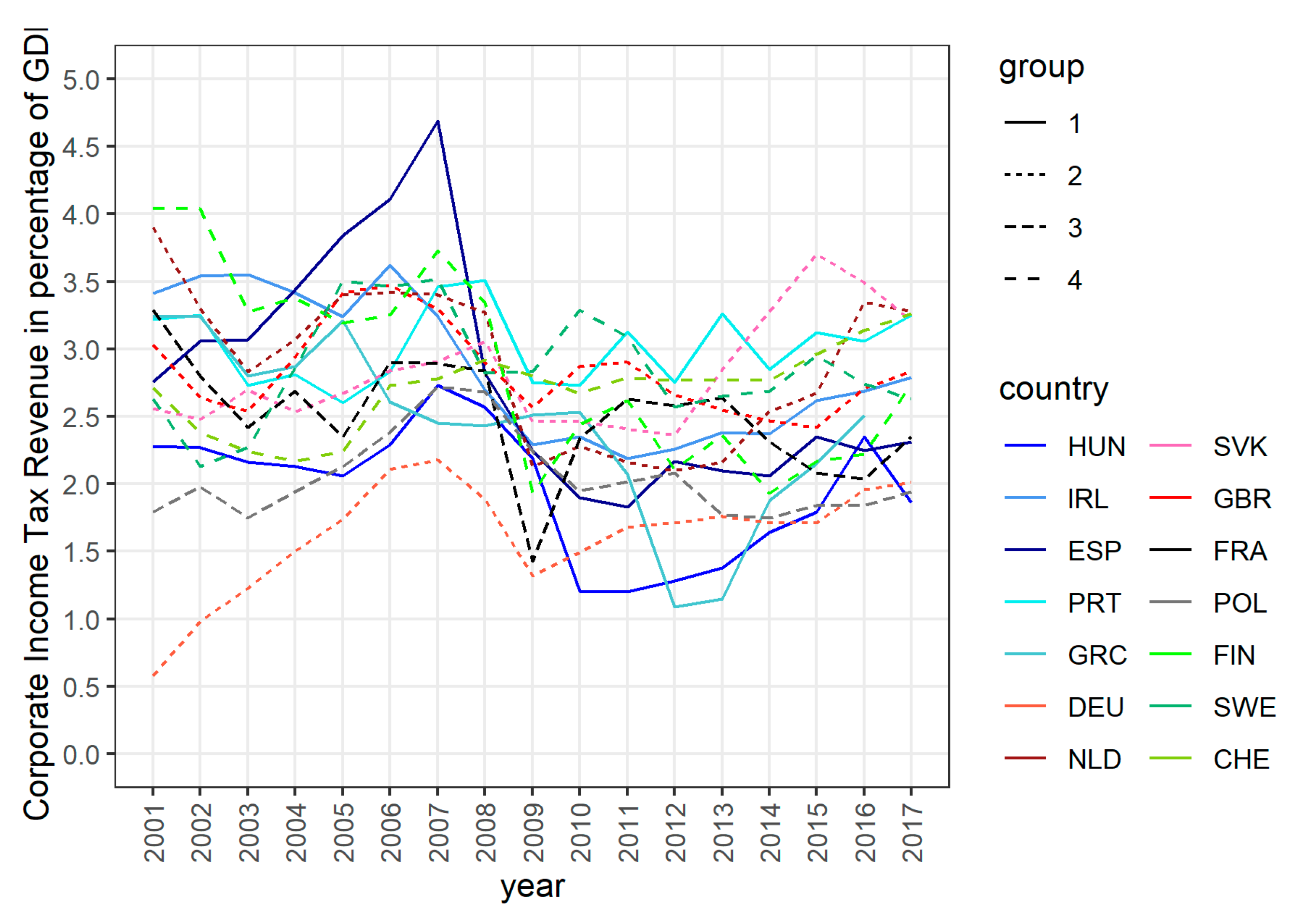
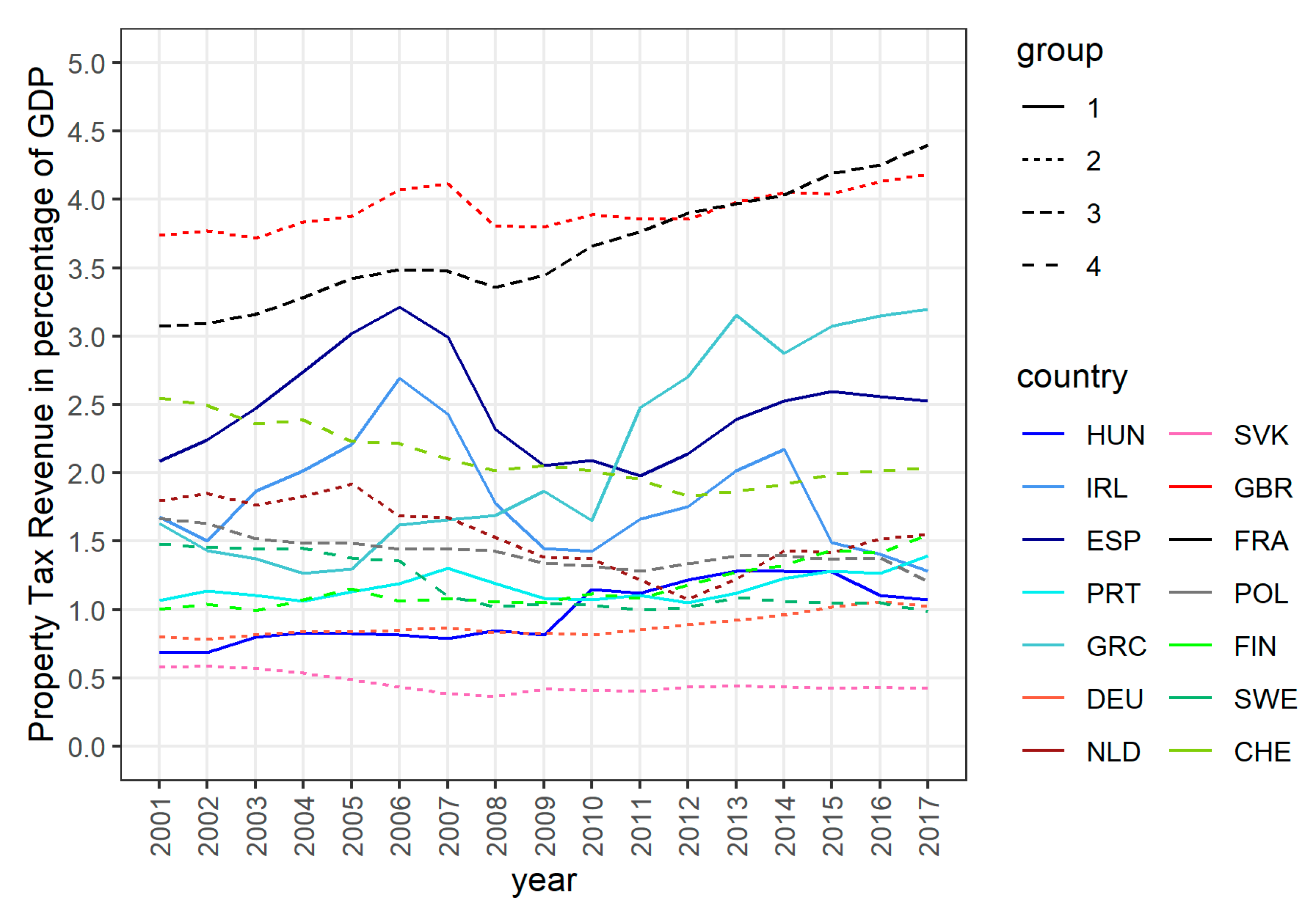
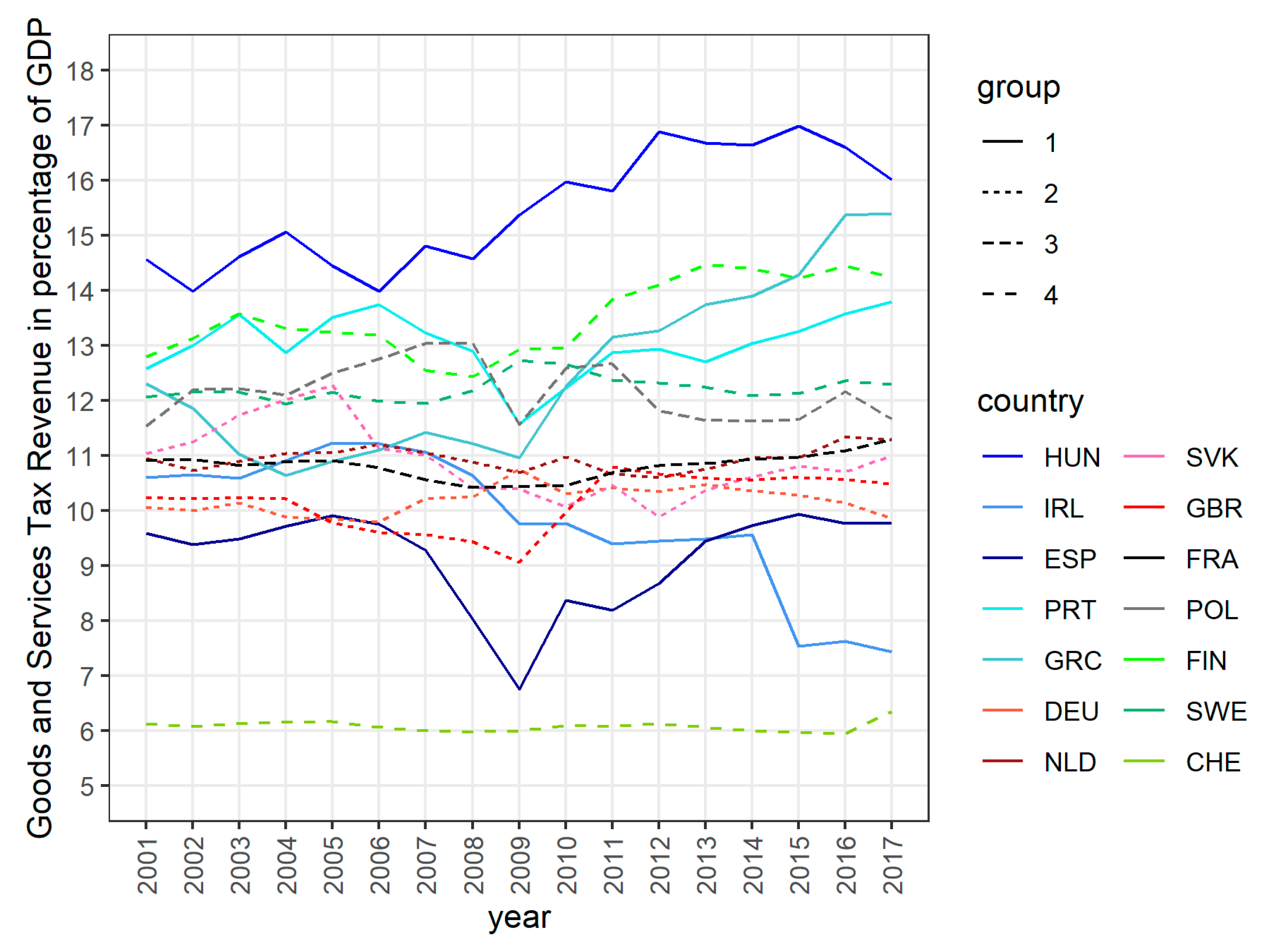
| PM | FM | |||
|---|---|---|---|---|
| Regression Coefficient | p-Value | Regression Coefficient | p-Value | |
| PITR | −46,153.7 | 0.027 | 5775.6 | 0.700 |
| CITR | −144,551 | 0.002 | −28,025.5 | 0.020 |
| PTR | 227,780.3 | <0.001 | 72,750.3 | 0.113 |
| DEF | 9738.6 | 0.19 | 94.7 | 0.959 |
| DEBT | −1384.1 | 0.11 | 315.5 | 0.234 |
| GTR | −70,369.5 | <0.001 | −37,311.2 | 0.007 |
| IR | −26,952.9 | 0.025 | −11,077.7 | 0.203 |
| CCI | −25,030.1 | 0.187 | −8995.2 | 0.119 |
| PM | FM | |||
|---|---|---|---|---|
| Regression Coefficient | p-Value | Regression Coefficient | p-Value | |
| PITR | 185,843.7 | 0.000 | 136,700.6 | 0.000 |
| CITR | −516,424.0 | 0.000 | −101,089.0 | 0.079 |
| PTR | 94,962.0 | 0.275 | 577,000.1 | 0.000 |
| DEF | 92,066.7 | 0.001 | 30,460.0 | 0.007 |
| DEBT | 11,980.6 | 0.006 | 4262.9 | 0.021 |
| GTR | −458,229.0 | <0.001 | −74,839.1 | 0.084 |
| IR | 67,232.6 | 0.161 | −29,486.8 | 0.149 |
| CCI | 87,290.1 | 0.019 | 10,309.4 | 0.458 |
| PM | FM | |||
|---|---|---|---|---|
| Regression Coefficient | p-Value | Regression Coefficient | p-Value | |
| PITR | 185,843.7 | 0.000 | 136,700.6 | 0.000 |
| CITR | −516,424.0 | 0.000 | −101,089.0 | 0.079 |
| PTR | 94,962.0 | 0.275 | 577,000.1 | 0.000 |
| DEF | 92,066.7 | 0.001 | 30,460.0 | 0.007 |
| DEBT | 11,980.6 | 0.006 | 4262.9 | 0.021 |
| GTR | −458,229.0 | <0.001 | −74,839.1 | 0.084 |
| IR | 67,232.6 | 0.161 | −29,486.8 | 0.149 |
| CCI | 87,290.1 | 0.019 | 10,309.4 | 0.458 |
| PM | FM | |||
|---|---|---|---|---|
| Regression Coefficient | p-Value | Regression Coefficient | p-Value | |
| PITR | 51,884.6 | <0.001 | 25,508.9 | 0.000 |
| CITR | 59,293.7 | 0.029 | 38,597.4 | 0.015 |
| PTR | −263,748 | <0.001 | −15,579.8 | 0.697 |
| DEF | −19,901.1 | 0.009 | −13,677.1 | 0.002 |
| DEBT | 1239.6 | 0.46 | −4984.3 | 0.000 |
| GTR | −88,139.1 | <0.001 | −21,602.6 | 0.127 |
| IR | −51,410.8 | <0.001 | −55,667.6 | 0.000 |
| CCI | −5,074.2 | 0.223 | −5816.6 | 0.017 |
© 2020 by the authors. Licensee MDPI, Basel, Switzerland. This article is an open access article distributed under the terms and conditions of the Creative Commons Attribution (CC BY) license (http://creativecommons.org/licenses/by/4.0/).
Share and Cite
Oravský, R.; Tóth, P.; Bánociová, A. The Ability of Selected European Countries to Face the Impending Economic Crisis Caused by COVID-19 in the Context of the Global Economic Crisis of 2008. J. Risk Financial Manag. 2020, 13, 179. https://doi.org/10.3390/jrfm13080179
Oravský R, Tóth P, Bánociová A. The Ability of Selected European Countries to Face the Impending Economic Crisis Caused by COVID-19 in the Context of the Global Economic Crisis of 2008. Journal of Risk and Financial Management. 2020; 13(8):179. https://doi.org/10.3390/jrfm13080179
Chicago/Turabian StyleOravský, Róbert, Peter Tóth, and Anna Bánociová. 2020. "The Ability of Selected European Countries to Face the Impending Economic Crisis Caused by COVID-19 in the Context of the Global Economic Crisis of 2008" Journal of Risk and Financial Management 13, no. 8: 179. https://doi.org/10.3390/jrfm13080179
APA StyleOravský, R., Tóth, P., & Bánociová, A. (2020). The Ability of Selected European Countries to Face the Impending Economic Crisis Caused by COVID-19 in the Context of the Global Economic Crisis of 2008. Journal of Risk and Financial Management, 13(8), 179. https://doi.org/10.3390/jrfm13080179





